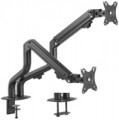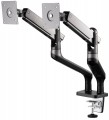Max. weight
The maximum weight of the TV that can be installed on the mount/stand; more specifically, it is the maximum weight that the mount/stand can support for an indefinitely long time without any negative consequences. Unlike the screen size described above, this parameter is accurate and should not be exceeded: perhaps the stand/mount will not break immediately under excess weight, but this can happen at any time, and such a breakdown is not covered by the warranty.
It is worth considering that for classic stands with several shelves (see "Type"), the maximum wheight is usually indicated for the entire structure as a whole and is the sum of the loads for each individual shelf. Thus, the maximum weight of the TV is not limited by the total maximum wheight, but by the maximum wheight for one shelf. This does not apply to stands with mounts; they usually list the maximum wheight on the mount, in which case it corresponds to the maximum weight of the TV.
The screen size is directly related to the maximum wheight (after all, a large TV weighs more). Typically, for screens up to 24", structures with a maximum wheight of about 5-6 kg are usually quite enough, for a 32" device, about 12 kg may be needed, large 55" screens reach a maximum weight of about 25-30 kg, and in the case of plasma panels, these figures increase by 1.5-2 times However, anyway, before choosing, you should clarify the weight of the specific TV model for which the stand/mount is selected.
Adjustments
The ability to change the position of the TV installed on the mount. Adjustments make it possible to optimally adjust the location of the screen; the more there are adjustments, the wider the customization options.
—
For curved TVs. Stands designed for use with curved TVs. Such TVs are becoming increasingly popular — it is believed that the curved shape has a positive effect on the image quality. Note that the dimensions and curvature of such screens can be different, so the compatibility of the stand with a specific TV has to be clarified separately.
—
Tilt. The ability to adjust the tilt of the installed TV forward and backward relative to the vertical position. It will be useful if the TV is not installed at eye level, and also if the height of the audience changes (for example, if you are sitting on the sofa, then on the floor, depending on your mood).
—
Turn. The ability to turn the TV around a vertical axis, from side to side. This gives a certain freedom in moving around the room — by moving to another point, you can turn the TV in the right direction and watch comfortably.
—
Depth adjustment. The ability to move the TV back and forth relative to the point of attachment to the wall without changing the angle of the screen. Can be used in combination with turn — for example, if at a selected
...point in the room an object on the side of the TV is blocking it, the screen can be pulled out from behind the obstruction and turned for the optimal viewing angle.
— Slide. The ability to move the TV from side to side relative to the point of attachment to the wall without changing the angle of the screen. This can be useful, for example, when rearranging: by moving the TV to the side, you can install a piece of furniture next to it that did not fit there before, without rearranging the mount itself. It can also be used in conjunction with turn, similar to depth adjustment (see above).
— Rotation. The ability to rotate the installed monitor around the horizontal axis, in other words, the ability to rotate the screen from a horizontal position (“landscape” orientation) to a vertical (“portrait”) one. In everyday use, this function is practically not in demand, and therefore is rare. At the same time, it can be useful for specialized purposes — for example, if the screen is used as a monitor and you need to work with vertically stretched materials (graphics or texts).
— Height adjustment. The ability to adjust the height of the TV on the mount. Allows you to optimally adjust the position of the screen relative to eye level, surrounding objects, etc.Upward tilt angle
The maximum upwards tilt angle from the vertical of the installed screen. The larger the tilt angle, the wider the adjustment possibilities, however, in fact, an angle of more than 5° is rarely required.
Downward tilt angle
The maximum downward tilt angle from the vertical for the installed screen. As with the upward tilt angle, the larger this angle, the wider the adjustment possibilities; however, downward tilt is usually required more frequently (the TV may be installed under the ceiling), and its angle can be as high as 15-20°.
Turn angle
The angle within which the screen installed on the mount can rotate. Measured from far left to far right. In modern models, it can reach 180°.

